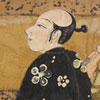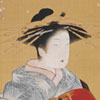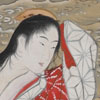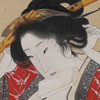Although Japanese artists had depicted courtly scenes, religious accounts, nature studies, and seasonal landscapes for hundreds of years, it was not until the late sixteenth century that genre painting became popular. As the country recovered from a protracted period of warfare and gradually rebuilt its ravaged cities, artists began to take note of the everyday world and the colorful, ordinary people inhabiting it. Their initial efforts featured scenes of daily work and occasional pastimes executed on panoramic, painted screens. Often rendered as vignettes glimpsed through gilded clouds, these images showed commoners visiting famous places, enjoying maple leaves or cherry blossoms, and participating in annual parades and celebrations.
In order to channel and control leisure activities in Japan's major cities, the military authorities designated certain areas as licensed "pleasure quarters." Within the Yoshiwara (Tokyo), Shimabara (Kyoto), and Shinmachi (Osaka), visitors could glimpse the reigning courtesans of the day. These women, with their gorgeous robes, elaborate coiffures, and seductive affectations, became arbiters of style. They were thoroughly trained not only in music, song, and dance, but also sometimes in the arts of calligraphy, poetry, flower arrangement, and tea practice.
For most men, an assignation with a high-ranking courtesan was beyond their means, but even they might enjoy the attentions of a lower-ranking beauty, such as a geisha (professional entertainer) or a teahouse waitress. Skillfully painted and highly detailed images of famous courtesans became a popular commodity among wealthy visitors to the floating world and served as mementos of the exotic pleasures encountered there.


























